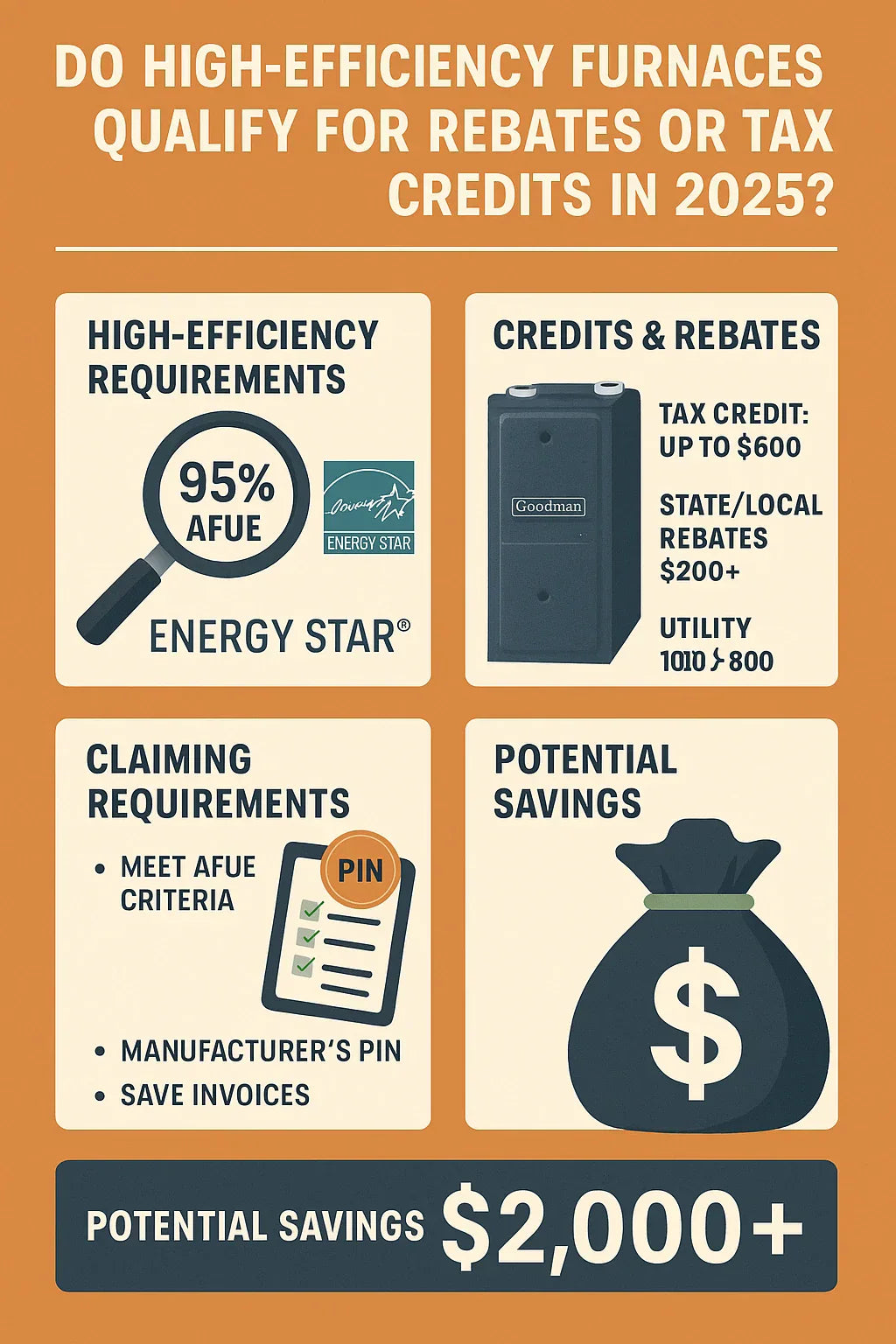Upgrading to a high‑efficiency furnace isn’t just a win for your comfort and energy bills—it can also score you serious rebates and tax credits in 2025. But the incentives landscape is full of fine print: varying federal rules, distinct state programs, and time‑sensitive manufacturer deals. In this guide, I’ll walk you through everything Tony-style—clear, actionable, and grounded in real data.
What Counts as a "High-Efficiency Furnace" in 2025? 🔍
“High efficiency” usually means 95% AFUE or higher—a big improvement over typical 80% units.
-
AFUE (Annual Fuel Utilization Efficiency) measures how much fuel becomes usable heat.
-
ENERGY STAR-certified models meet or exceed these thresholds and are required for most incentives.
Key modern features that boost efficiency include:
-
Variable-speed ECM blowers
-
Condensing heat exchangers
-
Sealed combustion systems
1. Federal Tax Credits (Section 25C – IRA) 🏛️
The Inflation Reduction Act (IRA) revamped tax incentives, including extension of the Energy Efficient Home Improvement Credit (IRC Section 25C):
-
30% of total cost (equipment + installation)
-
Up to $600 for furnaces
-
Effective through December 31, 2025
Eligible units must be:
-
ENERGY STAR-certified with the right AFUE levels (often ≥ 97%)
-
Installed in a primary residence in the U.S. during 2025
How to claim:
-
Submit IRS Form 5695 with your tax return
-
Keep invoices and manufacturer’s certifications
Also note: Improved 2025 rules now require a Product Identification Number (PIN) on qualifying equipment, to prevent fraud
Pairing with heat pumps?
If paired with a qualifying heat pump setup, total credits can reach up to $2,600—but rules vary by system type
2. State & Local Rebates 🗺️
State-level programs vary widely. Many offer substantial incentives—$200 to over $1,000—especially for high-efficiency furnaces installed in 2025.
Some programs are built on IRA funding, but not all are live yet:
-
Only 11 states (plus DC) are actively accepting applications as of March 2025
-
The rest are awaiting rollout.
To check current availability and eligibility:
3. Manufacturer & Dealer Promotions 🏭
Big-name HVAC brands like Goodman, Trane, Lennox, Carrier, and others offer rebates on high-efficiency models:
-
Typically range from $150–$500
-
Available for ENERGY STAR units
-
Sometimes bundled with utility or federal incentives
To find them:
-
Check manufacturer websites
-
Visit local dealer showrooms
-
Ask for incentives at quote time
4. Utility Company & Program Rebates 🔌
Many utilities—especially gas providers—offer:
-
Instant rebates at purchase
-
Incentives for smart thermostat pairings
-
Seasonal deals
Typical savings: $100–$800 depending on your location and equipment type
Check energy provider websites or use rebate tools to compare eligibility in your area.
5. Low-Income & Future IRA Home Rebates 🏘️
Two major IRA rebate programs offer broader, income-based support:
-
Home Energy Rebate Programs (HEAR / HOMES): funded but not fully live in many states
-
Home Electrification Rebate (HEEHRA): up to $14,000 in upgrades for eligible households
These programs overlap with efficiencies, especially if you’re installing heat pumps or hybrid systems.
6. How to Claim All Eligible Credits & Rebates 📋
Here’s a step‑by‑step breakdown (Tony-style):
-
Confirm qualification:
-
ENERGY STAR status
-
Manufacturer PIN for tax credit
-
-
Keep documentation:
-
Invoices with breakdown of labor & equipment
-
Efficiency certifications
-
-
Apply strategically:
-
Federal: IRS Form 5695 (cost deduction limited annually)
-
State: Utility or state rebate portal
-
Manufacturer: Online submission
-
-
Stack smart:
-
Federal + State + Utility + Manufacturer often stack—but always check overlap restrictions
-
-
File on time:
-
Use Form 5695 with 2025 return
-
Save receipts for 3–5 years
-
7. Long-Term Savings from High-Efficiency Furnaces 💡
Beyond upfront incentives, you also save on fuel bills:
-
Upgrading from 80% to ≥ 95% AFUE may save 10–15% annually—$500+ per year in colder climates
-
Over 10 years, that’s $5,000+ saved—well beyond rebate value.
Stacking rebates, tax credits, and efficiency gains can cut total costs up to 50% in some scenarios
8. Common Pitfalls & What to Avoid ⚠️
-
Installing a non-ENERGY STAR or low-AFUE model
-
Forgetting to get and submit the correct PIN
-
Missing rebate deadlines
-
Assuming all rebates stack automatically—some don’t
-
Overlooking the labor-included rule for tax credits
9. Future Trends: Furnaces vs. Heat Pumps? 🔄
The U.S. is shifting more toward electrification:
-
Heat pumps earn higher credits ($2,000+)
-
Some states are prioritizing heat pump rebates over furnace incentives
But for now, high-efficiency furnaces remain one of the most accessible, reliable options—especially where electric upgrades aren’t practical.
Final Takeaways ✅
-
Yes, high-efficiency furnaces qualify for 2025 rebates and tax credits—but you must meet the criteria, including ENERGY STAR certification and manufacturer PIN.
-
You can stack savings: Federal (up to $600) + State (up to $1,000+) + Utility (up to $800) + Manufacturer (up to $500).
Total potential savings: $2,000+ -
Combined with energy bill reductions, upgrading to a high-AFUE furnace pays off fast—often within 5–7 years.
Your next step, Tony-style? Call a local HVAC contractor, ask about ENERGY STAR ≥ 95% AFUE models, and apply for everything you qualify for. Don’t sleep on those incentives!
In the next topic we will know more about: Troubleshooting Guide: What to Do If Your Furnace Won’t Start or Heat Properly







